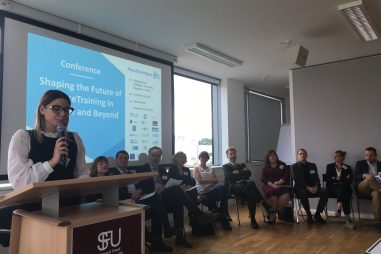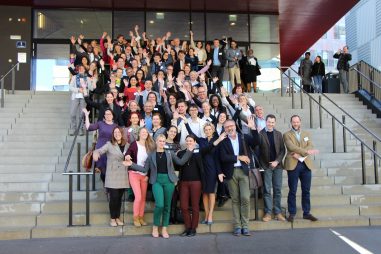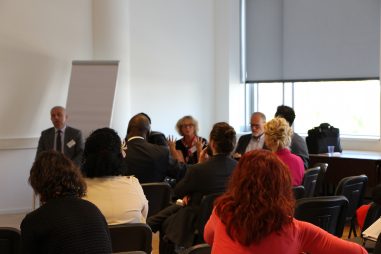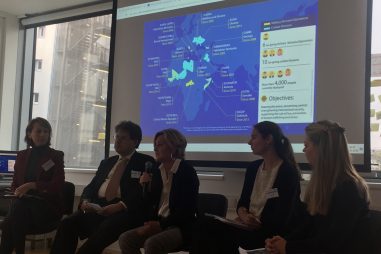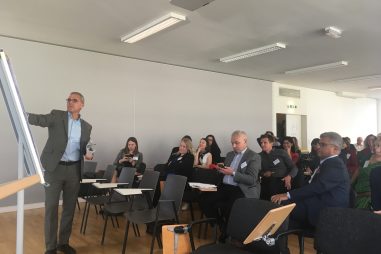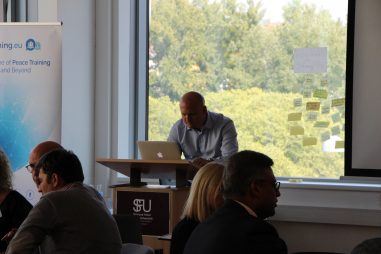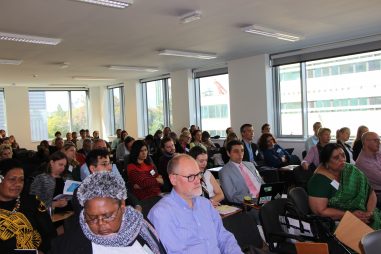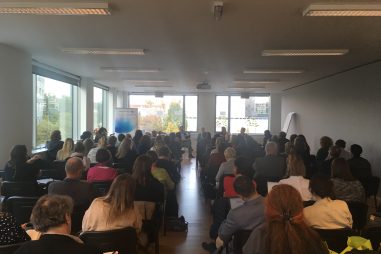The PeaceTraining.eu Conference in Vienna
PEACE TRAINING is a dynamic field which requires creativity and innovation but also constant engagement, information sharing and coordination among its practitioners. Thus, to contribute in creating a forum for collaborative engagements among different stakeholders in CPPB, Peactraining.eu organised a Practitioners Conference at the Sigmund Freud Private University in Vienna in Vienna from 1-2 October 2018. The conference which was titled “Shaping the Future of Peace Training in Europe and Beyond”, brought together about 150 practitioners from over 37 countries around the world and across different sectors including civil society organisations, training institutions, military, diplomatic and research institutions. The purpose of conference was to create a conducive environment for discourses around the future of peacetraining not only in Europe but worldwide. More importantly, we aimed to share with other actors from training and conflict prevention and peacebuilding (CPPB) practice our project results which included, inter alia workshops, reports, academic publications, a multi-functional web platform and CPPB handbook.
The conference was a great success. The 20 workshops, panels and informal spaces were refreshingly interactive and extremely rewarding. In the words of Picasso, “inspiration exists, but it has to find you working”; and indeed, as practitioners interacted and harmoniously worked together at the conference, inspiration thrived.
For many participants, the conversations and ideas sharing did not only inspire them professionally but also personally. The keynote address and plenary on the first day provided a useful and critical foundation by laying down the contextual relevance and realities in the field as well as facilitating an “energetic and interesting” discussions. The Plenary One titled ‘Mapping the Needs and Challenges in the Field of Peace Training’ in particular elicited enthusiasm among the participants who in the spirit of camaraderie openly engaged in the group discussions; ‘providing a momentum’ which made the conference special and fit for purpose. Plenaries and workshops on novelty, self-care and stress management, CSDP training, e-learning methods and approaches, leadership development, networking among others were professionally inspiring and personally motivating. One participant noted of her experience from the session on self-care and stress management: “It has reminded me about the importance of the “human factor” in peace training and that courses can and should do much more in preparing staff working in difficult environments…It inspired me to include self-care and stress management techniques in modules in courses I design and organize.”
Furthermore, it is said that ‘iron sharpens iron’ and indeed, the creation of such collaborative spaces allowed for the co-creation of new knowledge and learnings as well as much needed ‘fresh’ insights as participants interacted and shared their experiences with each other. Over the course of the 2-day conference, participants learnt new tools and ideas from each other which they could apply in their CPPB work. Serious games such as Mission Zhobia ; arts-based methods such as image sculpting and participatory videos; USIP online courses on CPPB ; and human-centred approach to training; were among the many new learnings which participants benefitted from.
The demonstration of Mission Zhobia expounded the complexities of using and evaluating the impact of technological/computer-based games in training especially in conflict settings, whilst highlighting the potential benefits such games could have in future CPPB trainings. These workshops proved that “accessible forms of e-learning, serious gaming and simulation have a huge potential that should be explored, tested and evaluated in the future.” Additionally, “micro-courses” such as those introduced by USIP are not only cost-effective and time saving tools for self-paced learning, but also a step towards the development of more innovative tools such as mobile/smartphone training apps. These will facilitate easy access by trainees across different continents.
Undeniably, while progress has been made, there are also challenges which continue to persist in the practice of CPPB and peace training; some of which were equally underscored during the conference and are consistent with our project findings see reports.
- The persisting disconnect between training and needs on the ground. Notably, personnel competencies often do not match needs of benefactors in the field creating a lacunae in the effective delivery of CPPB. Here, the development of a comprehensive competency framework in CPPB was emphasized.
- The lack of local ownership which continues to exist in CPPB spaces limiting the recognition, participation and inclusion of local capacities and efforts. In cases where they are allowed to participate, there is a limit to the extent of such participation and inclusion. In CPPB however, creating the spaces for inclusivity and collectivism among all actors is essential to its successful implementation as they each bring to the fold their unique expertise and contributions.
- The limited tools for evaluating the utility and impact of training. As one representative noted; “finding the right tools or indicators to assess training received by personnel and their application in the field of practice is still lacking; and this is so for both online and offline courses.”
- The lack of clarity in the mandates which govern CPPB activities sometimes affects the training and capacities required in missions. One representative noted that her interactions in one of the sessions revealed a divide between training and the goals of the missions and that it “was necessary to question whether the mandate was exclusively to contain violence or also contribute to the resolution of positive transformation of the conflict.” Doing so, will ultimately help trainers and training institutions match training contents and approaches to the needs and capacities required in the field.
The existence of these challenges demonstrates that CPPB is often a gradual and long-term process. Thus, to address these gaps and ensure the effective implementation of future CPPB interventions, the following recommendations were underscored.
- There is the need to create opportunities and spaces to expand the reach of the Peacetraining.eu project globally to enable the sharing of best practices and lessons in training methods, content and approaches. One way to do this is to “foster a global community of practice such as online Trainer Working Group or regional, annual meetings to deepen personal ties and exchanges.” Such fora and online platforms provided as a feature on the PeaceTraining.eu for example, could be used for the co-creation of training courses and materials; foster debates; as well as enhance understanding of the different contexts and cultures so as to maximize our commonalities and shared values and minimize our differences.
- There is the need for continued discussions and knowledge exchanges on good practices on the integration of gender perspectives in peace trainings to overcome the persistent narratives, stereotypes and practices of exclusion.
- It will be useful for peacetraining to expand its focus to include civil society and not only mission personnel as the former plays an equally important role in CPPB.
- Future trainings must strengthen personnel capacities in fostering local ownership, conflict and culture sensitivities by equipping “them with tools to effectively assess and incorporate the interests, voices and needs of local population into their strategic action, creating peacebuilding missions that support local peacebuilding and not impose their perspective on what peace actually is.” This can be done through “de-colonizing curricula idea by bringing together trainers and participants from all over the world (e.g. promoted and searched through PT platform); and developing integrated course materials which includes case studies reflecting diversity of local approaches.”
- It will also be beneficial for organisations and training institutions to consider and encourage the use of existing and emerging information and communication technology (ICT) in their training and capacity building programmes. While the practical demonstrations of serious games and other e-learning methods expounded the complexities around its application, it equally highlighted its utility in future CPPB training.
- There is also a requirement for more reflections on training methodologies and approaches, as well as a shift from more generic discussions of peacebuilding to more narrow discourses such as the “challenges of dealing with diverse audiences.”
- As CPPB is a dynamic field, novelty or innovation ought to be a constant practice. While doing so, it is important to acknowledge that “disruptive or revolutionary innovations” are as important as “renovation over innovation” as were emphasized at the conference. Thus, while the development of ground-breaking novelty is essential, the‘re-innovation’ of existing tools are equally useful in meeting contemporary CPPB training needs with critical consideration to the context.
From the foregoing, the Peacetraining.eu Practitioner’s Conference provided a strong foundation for more discourses, debates, engagements and interactions among the different stakeholders and practitioners in the field who were present; which evidently is a much needed forum in CPPB
Video
Conference Materials
Shaping The Future Religion in Conflict for Peacebuilding
Workshop Report Addressing Relegious Content and Actors in Peace Work
Please send us your materials at office@peacetraining.eu if you want them to be featured on our platform!
Partners
Shaping the Future of Peace Training in Europe and Beyond is a collaborative initiative of the PeaceTraining.eu Consortium, the European Peacebuilding Liaison Office (EPLO), the Global Partnership for the Prevention of Armed Conflict (GPPAC), the European Security and Defence College (ESDC), the Peace and Collaborative Development Network (PCDN) and The Civilian Planning and Conduct Capability (CPCC) of the EEAS.
The PeaceTraining.eu Conference in Vienna
PEACE TRAINING is a dynamic field which requires creativity and innovation but also constant engagement, information sharing and coordination among its practitioners. Thus, to contribute in creating a forum for collaborative engagements among different stakeholders in CPPB, Peactraining.eu organised a Practitioners Conference at the Sigmund Freud Private University in Vienna in Vienna from 1-2 October 2018. The conference which was titled “Shaping the Future of Peace Training in Europe and Beyond”, brought together about 150 practitioners from over 37 countries around the world and across different sectors including civil society organisations, training institutions, military, diplomatic and research institutions. The purpose of conference was to create a conducive environment for discourses around the future of peacetraining not only in Europe but worldwide. More importantly, we aimed to share with other actors from training and conflict prevention and peacebuilding (CPPB) practice our project results which included, inter alia workshops, reports, academic publications, a multi-functional web platform and CPPB handbook.
The conference was a great success. The 20 workshops, panels and informal spaces were refreshingly interactive and extremely rewarding. In the words of Picasso, “inspiration exists, but it has to find you working”; and indeed, as practitioners interacted and harmoniously worked together at the conference, inspiration thrived.
For many participants, the conversations and ideas sharing did not only inspire them professionally but also personally. The keynote address and plenary on the first day provided a useful and critical foundation by laying down the contextual relevance and realities in the field as well as facilitating an “energetic and interesting” discussions. The Plenary One titled ‘Mapping the Needs and Challenges in the Field of Peace Training’ in particular elicited enthusiasm among the participants who in the spirit of camaraderie openly engaged in the group discussions; ‘providing a momentum’ which made the conference special and fit for purpose. Plenaries and workshops on novelty, self-care and stress management, CSDP training, e-learning methods and approaches, leadership development, networking among others were professionally inspiring and personally motivating. One participant noted of her experience from the session on self-care and stress management: “It has reminded me about the importance of the “human factor” in peace training and that courses can and should do much more in preparing staff working in difficult environments…It inspired me to include self-care and stress management techniques in modules in courses I design and organize.”
Furthermore, it is said that ‘iron sharpens iron’ and indeed, the creation of such collaborative spaces allowed for the co-creation of new knowledge and learnings as well as much needed ‘fresh’ insights as participants interacted and shared their experiences with each other. Over the course of the 2-day conference, participants learnt new tools and ideas from each other which they could apply in their CPPB work. Serious games such as Mission Zhobia ; arts-based methods such as image sculpting and participatory videos; USIP online courses on CPPB ; and human-centred approach to training; were among the many new learnings which participants benefitted from.
The demonstration of Mission Zhobia expounded the complexities of using and evaluating the impact of technological/computer-based games in training especially in conflict settings, whilst highlighting the potential benefits such games could have in future CPPB trainings. These workshops proved that “accessible forms of e-learning, serious gaming and simulation have a huge potential that should be explored, tested and evaluated in the future.” Additionally, “micro-courses” such as those introduced by USIP are not only cost-effective and time saving tools for self-paced learning, but also a step towards the development of more innovative tools such as mobile/smartphone training apps. These will facilitate easy access by trainees across different continents.
Undeniably, while progress has been made, there are also challenges which continue to persist in the practice of CPPB and peace training; some of which were equally underscored during the conference and are consistent with our project findings see reports.
- The persisting disconnect between training and needs on the ground. Notably, personnel competencies often do not match needs of benefactors in the field creating a lacunae in the effective delivery of CPPB. Here, the development of a comprehensive competency framework in CPPB was emphasized.
- The lack of local ownership which continues to exist in CPPB spaces limiting the recognition, participation and inclusion of local capacities and efforts. In cases where they are allowed to participate, there is a limit to the extent of such participation and inclusion. In CPPB however, creating the spaces for inclusivity and collectivism among all actors is essential to its successful implementation as they each bring to the fold their unique expertise and contributions.
- The limited tools for evaluating the utility and impact of training. As one representative noted; “finding the right tools or indicators to assess training received by personnel and their application in the field of practice is still lacking; and this is so for both online and offline courses.”
- The lack of clarity in the mandates which govern CPPB activities sometimes affects the training and capacities required in missions. One representative noted that her interactions in one of the sessions revealed a divide between training and the goals of the missions and that it “was necessary to question whether the mandate was exclusively to contain violence or also contribute to the resolution of positive transformation of the conflict.” Doing so, will ultimately help trainers and training institutions match training contents and approaches to the needs and capacities required in the field.
The existence of these challenges demonstrates that CPPB is often a gradual and long-term process. Thus, to address these gaps and ensure the effective implementation of future CPPB interventions, the following recommendations were underscored.
- There is the need to create opportunities and spaces to expand the reach of the Peacetraining.eu project globally to enable the sharing of best practices and lessons in training methods, content and approaches. One way to do this is to “foster a global community of practice such as online Trainer Working Group or regional, annual meetings to deepen personal ties and exchanges.” Such fora and online platforms provided as a feature on the PeaceTraining.eu for example, could be used for the co-creation of training courses and materials; foster debates; as well as enhance understanding of the different contexts and cultures so as to maximize our commonalities and shared values and minimize our differences.
- There is the need for continued discussions and knowledge exchanges on good practices on the integration of gender perspectives in peace trainings to overcome the persistent narratives, stereotypes and practices of exclusion.
- It will be useful for peacetraining to expand its focus to include civil society and not only mission personnel as the former plays an equally important role in CPPB.
- Future trainings must strengthen personnel capacities in fostering local ownership, conflict and culture sensitivities by equipping “them with tools to effectively assess and incorporate the interests, voices and needs of local population into their strategic action, creating peacebuilding missions that support local peacebuilding and not impose their perspective on what peace actually is.” This can be done through “de-colonizing curricula idea by bringing together trainers and participants from all over the world (e.g. promoted and searched through PT platform); and developing integrated course materials which includes case studies reflecting diversity of local approaches.”
- It will also be beneficial for organisations and training institutions to consider and encourage the use of existing and emerging information and communication technology (ICT) in their training and capacity building programmes. While the practical demonstrations of serious games and other e-learning methods expounded the complexities around its application, it equally highlighted its utility in future CPPB training.
- There is also a requirement for more reflections on training methodologies and approaches, as well as a shift from more generic discussions of peacebuilding to more narrow discourses such as the “challenges of dealing with diverse audiences.”
- As CPPB is a dynamic field, novelty or innovation ought to be a constant practice. While doing so, it is important to acknowledge that “disruptive or revolutionary innovations” are as important as “renovation over innovation” as were emphasized at the conference. Thus, while the development of ground-breaking novelty is essential, the‘re-innovation’ of existing tools are equally useful in meeting contemporary CPPB training needs with critical consideration to the context.
From the foregoing, the Peacetraining.eu Practitioner’s Conference provided a strong foundation for more discourses, debates, engagements and interactions among the different stakeholders and practitioners in the field who were present; which evidently is a much needed forum in CPPB
Video
Conference Materials
Shaping The Future Religion in Conflict for Peacebuilding
Workshop Report Addressing Relegious Content and Actors in Peace Work
Please send us your materials at office@peacetraining.eu if you want them to be featured on our platform!
Partners
Shaping the Future of Peace Training in Europe and Beyond is a collaborative initiative of the PeaceTraining.eu Consortium, the European Peacebuilding Liaison Office (EPLO), the Global Partnership for the Prevention of Armed Conflict (GPPAC), the European Security and Defence College (ESDC), the Peace and Collaborative Development Network (PCDN) and The Civilian Planning and Conduct Capability (CPCC) of the EEAS.









